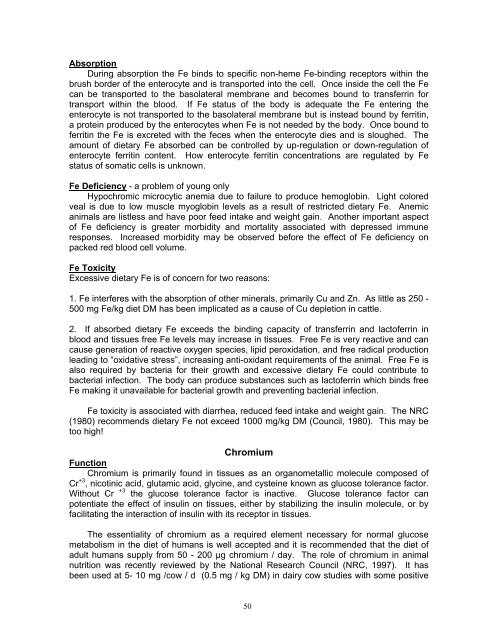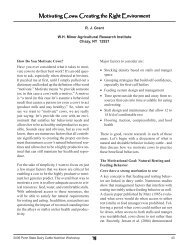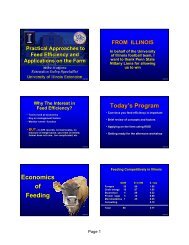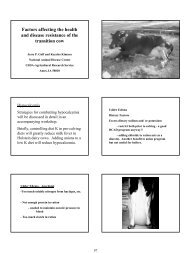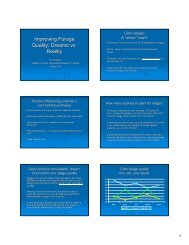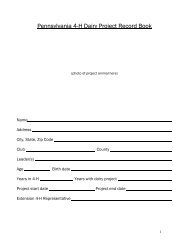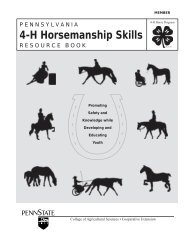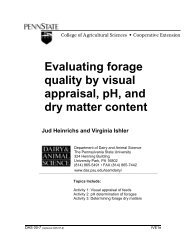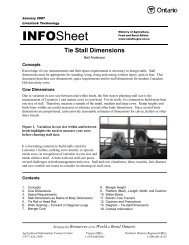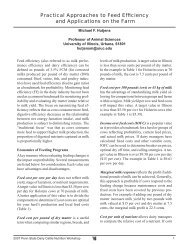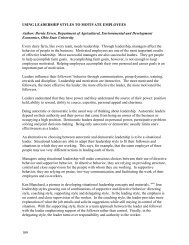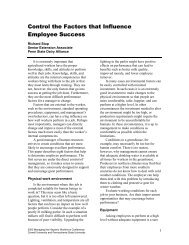DETERMINING THE MINERAL REQUIREMENT OF DAIRY CATTLE
DETERMINING THE MINERAL REQUIREMENT OF DAIRY CATTLE
DETERMINING THE MINERAL REQUIREMENT OF DAIRY CATTLE
Create successful ePaper yourself
Turn your PDF publications into a flip-book with our unique Google optimized e-Paper software.
Absorption<br />
During absorption the Fe binds to specific non-heme Fe-binding receptors within the<br />
brush border of the enterocyte and is transported into the cell. Once inside the cell the Fe<br />
can be transported to the basolateral membrane and becomes bound to transferrin for<br />
transport within the blood. If Fe status of the body is adequate the Fe entering the<br />
enterocyte is not transported to the basolateral membrane but is instead bound by ferritin,<br />
a protein produced by the enterocytes when Fe is not needed by the body. Once bound to<br />
ferritin the Fe is excreted with the feces when the enterocyte dies and is sloughed. The<br />
amount of dietary Fe absorbed can be controlled by up-regulation or down-regulation of<br />
enterocyte ferritin content. How enterocyte ferritin concentrations are regulated by Fe<br />
status of somatic cells is unknown.<br />
Fe Deficiency - a problem of young only<br />
Hypochromic microcytic anemia due to failure to produce hemoglobin. Light colored<br />
veal is due to low muscle myoglobin levels as a result of restricted dietary Fe. Anemic<br />
animals are listless and have poor feed intake and weight gain. Another important aspect<br />
of Fe deficiency is greater morbidity and mortality associated with depressed immune<br />
responses. Increased morbidity may be observed before the effect of Fe deficiency on<br />
packed red blood cell volume.<br />
Fe Toxicity<br />
Excessive dietary Fe is of concern for two reasons:<br />
1. Fe interferes with the absorption of other minerals, primarily Cu and Zn. As little as 250 -<br />
500 mg Fe/kg diet DM has been implicated as a cause of Cu depletion in cattle.<br />
2. If absorbed dietary Fe exceeds the binding capacity of transferrin and lactoferrin in<br />
blood and tissues free Fe levels may increase in tissues. Free Fe is very reactive and can<br />
cause generation of reactive oxygen species, lipid peroxidation, and free radical production<br />
leading to “oxidative stress”, increasing anti-oxidant requirements of the animal. Free Fe is<br />
also required by bacteria for their growth and excessive dietary Fe could contribute to<br />
bacterial infection. The body can produce substances such as lactoferrin which binds free<br />
Fe making it unavailable for bacterial growth and preventing bacterial infection.<br />
Fe toxicity is associated with diarrhea, reduced feed intake and weight gain. The NRC<br />
(1980) recommends dietary Fe not exceed 1000 mg/kg DM (Council, 1980). This may be<br />
too high!<br />
Chromium<br />
Function<br />
Chromium is primarily found in tissues as an organometallic molecule composed of<br />
Cr +3 , nicotinic acid, glutamic acid, glycine, and cysteine known as glucose tolerance factor.<br />
Without Cr +3 the glucose tolerance factor is inactive. Glucose tolerance factor can<br />
potentiate the effect of insulin on tissues, either by stabilizing the insulin molecule, or by<br />
facilitating the interaction of insulin with its receptor in tissues.<br />
The essentiality of chromium as a required element necessary for normal glucose<br />
metabolism in the diet of humans is well accepted and it is recommended that the diet of<br />
adult humans supply from 50 - 200 µg chromium / day. The role of chromium in animal<br />
nutrition was recently reviewed by the National Research Council (NRC, 1997). It has<br />
been used at 5- 10 mg /cow / d (0.5 mg / kg DM) in dairy cow studies with some positive<br />
50


